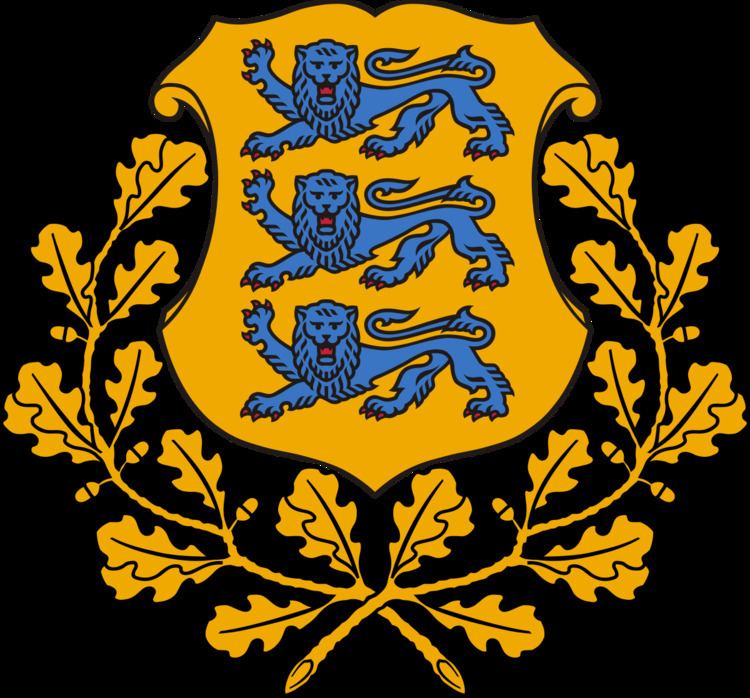 | ||
Estonian citizenship - based primarily on the principle of jus sanguinis - is governed by 19 January 1995 law promulgated by the Riigikogu which took effect on 1 April 1995. The Police and Border Guard Board (Estonian: Politsei- ja Piirivalveamet) is responsible for processing applications and enquiries concerning Estonian citizenship.
Contents
- By descent
- By place of birth
- By marriage
- By naturalisation
- Duties and rights of Estonian citizenship
- Undefined citizenship
- Dual nationality
- Citizenship of the European Union
- Travel freedom of Estonian citizens
- References
Resolution Concerning the Citizenship of the Democratic Republic of Estonia, the first Estonian citizenship law was adopted by the Estonian National Council on 26 November 1918. According to this law, all people who
regardless of their ethnicity and faith were proclaimed Estonian citizens.
The Citizenship Law adopted in 1922 defined the principles of succession by applying the jus sanguinis principle.
By descent
Children born to parents, at least one of whom was an Estonian citizen at the time of birth (regardless of the place of birth) are automatically considered Estonian citizens by descent.
By place of birth
Children born in Estonia are eligible for Estonian citizenship if at least one parent holds Estonian citizenship at the time of birth.
By marriage
A person who married an Estonian citizen before 26 February 1992 is eligible for Estonian citizenship.
By naturalisation
Those seeking to become Estonian citizens via naturalisation are required to fulfill the following criteria:
Those who have committed serious crimes or are foreign military personnel on active duty are ineligible to seek naturalisation as an Estonian citizen.
Duties and rights of Estonian citizenship
Undefined citizenship
'Undefined citizenship' (Estonian: kodakondsuseta isik, Russian: негражданин) is a term used in Estonia to denote a post-Soviet form of statelessness. It is applied to those migrants from former Soviet republics and their children, who were unable or unwilling to pursue any country's citizenship after the collapse of the Soviet Union. Russia being a successor state to the Soviet Union, all former USSR citizens qualified for citizenship of Russian Federation, available upon mere request, as provided by the law "On the RSFSR Citizenship" in force up to end of 2000. Estonia's policy of requiring naturalisation of post-war immigrants was in part influenced by Russia's citizenship law and the desire to prevent dual citizenship, and upon the established legal principle that persons who settle under the rule of an occupying power gain no automatic right to nationality. According to Peter Van Elsuwege, a scholar in European law at Ghent University, a number of historic precedents support this, most notably the case of Alsace-Lorraine when France on recovering the territory in 1918 did not automatically grant French citizenship to German settlers despite Germany having annexed the territory 47 years earlier in 1871.
Persons of undefined citizenship who reside legally in Estonia can apply for an alien's passport. Estonian alien's passport allows visa-free travel within Schengen treaty countries for a maximum of 90 days in a 6-month period. Alternatively they are entitled to naturalise as citizens and receive an Estonia passport, and more than half have opted to do so since 1992.
The European Commission against Racism and Intolerance, Advisory Committee on the Framework Convention for the Protection of National Minorities and UN Special Rapporteur on racism Doudou Diene recommend to Estonia simplifying naturalization generally or for the elderly and economically marginalized, as well as encouraging registration of children born in Estonia after 1991 as its citizens.
Dual nationality
Although not legally permitted, some naturalised Estonian citizens also possess another, e.g., Russian citizenship. According to law, acquiring a foreign citizenship voluntarily and entering into a military or civilian service for another state constitute forfeiture of Estonian citizenship. In effect, this forfeiture requirement applies to naturalised Estonian citizens only, because, according to the constitution, Estonian citizenship obtained by descent is inalienable and cannot be taken away by anyone else other than the citizenship holder.
Citizenship of the European Union
Estonian citizens are also citizens of the European Union and thus enjoy: rights of free movement and have the right to vote in elections for the European Parliament, Voting in municipal elections: a right to vote and stand in local elections in an EU state other than their own, under the same conditions as the nationals of that state (Article 22).. etc.
Travel freedom of Estonian citizens
Visa requirements for Estonian citizens are administrative entry restrictions by the authorities of other states placed on citizens of Estonia. In 2015, Estonian citizens had visa-free or visa-on-arrival access to 159 countries and territories, ranking the Estonian passport 13th in the world according to the Visa Restrictions Index.
